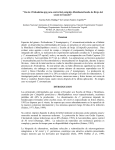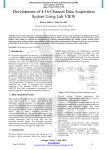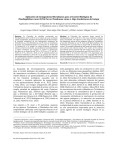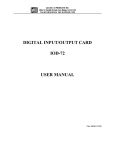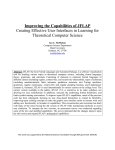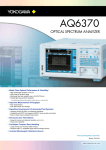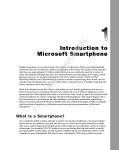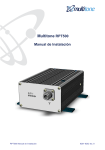Download IJESRT
Transcript
ISSN: 2277-9655 2277 [Sakhare, 2(4): April, 2013] IJESRT INTERNATIONAL JOURNA JOURNAL OF ENGINEERING SCIENCES ENCES & RESEARCH TECHNOLOGY Time for Action to End Violence against Women Radhika S Sakhare *1, Nikita V Hebbar 2, Sailee D Patil 3, Harshada M Wasade 4 *1, 2,3,4 Veermata Jijabai Technological Institute (VJTI), Mumbai Mumbai-400019, 400019, Maharashtra, India [email protected] Abstract Incidents of crime against women have been increasing at an alarming pace in Indian cities, most common incidents being rape, kidnapping, sexual harassment and eve teasing. While a lot of legal and NGO authorities are coming forward with their plans to prevent such crimes and make the cities safer for women, in this age of technology, mobile ile phone is one gadget almost everyone uses to keep in touch with family and friends. Women can definitely make good use of inbuilt technology to use their mobile phones as a SOS tool in case of emergencies. This paper describes a system using which a wom woman an in distress can call for help with the click of a button. Keywords: Crime rime against women, help with the click of a button, Interactive Voice Response System, mobile SOS tool. Introduction This is a personal safety service that instantly connects you with your safety network and authorities in an emergency. It employs a central database which contains the registered user’s profile. When in need of help or emergency the user can dial the service number umber and select various alert options by pressing a number key. This action sends a DTMF tone to the IVR system which then executes the selected service. The options will include sending a message to the emergency contact enlisted in the data base, sendingg notification to the police, sending users location through service providing or GPS or recording an emergency message. This is a convenient and easy-to-use use system which will provide instant notification to family and concerned authorities without drawing much attention. There are many mobile applications operating on platforms like android, iOS, Blackberry etc. which are aimed at women’s security. These applications require Smartphone and internet connections. However, everyone is not acquainted with Smartphone tphone and using apps. This system is designed for a wider range of users as it requires just basic phone with cellular services. • • • • EGSM 900 MHz, DCS 1800 MHz and PCS1900 MHz working on GSM networks in all countries across the world. wor Two serial ports for interfacing with computer. Speaker and Headphone jacks - so that you can send DTMF signals or play recording like an answering machine. Short Message Service - so that you can send small amounts of data over the network (ASCII or raw aw hexadecimal). The sim card corresponding to the service number is placed in the sim 300 sim card slot. The module is connected to a microcontroller through Max232 interface for serial communication. When a user calls the service number, the ring is detected dete and using AT command ATA the call gets received automatically. With the help of AT commands the user’s number is available. Elements of the System SIM300 GSM Module SIM300 is a Tri-band band GSM/GPRS engine that works on frequencies EGSM 900 MHz, DCS 1800 MHz and PCS1900 MHz. Key feature of sim300 used in our project are: • • http: // www.ijesrt.com (C) International Journal of Engineering Sciences & Research Technology[863-866] Technology ISSN: 2277-9655 [Sakhare, 2(4): April, 2013] Dual Tone Multi Frequency Technology I. Dual tone multi frequency technology uses mixture of two pure tones to represent a digit pressed on the phone keypad..The DTMF keypad is a 4×4 matrix, with each row representing a low frequency, and each column representing a high frequency. On pressing a single key (such as 1), a sinusoidal tone is sent for each of the two frequencies (697 and 1209Hz). The tones are sent to a DTMF decoder which converts these tones into corresponding 4 bit BCD number. In our project, the user selects alert options by pressing a key on the keypad. Received DTMF tone is then decoded and processed by the microcontroller to identify the alert option selected. II. M-8870 M-8870 operating function include a band split filter that separates the high and low tones of the received pair, and a digital decoder that verifies both the frequency and duration of the received tones before passing the resulting 4-bit code to the output bus. of registers providing enhanced features and accelerated port access or the legacy group of registers. We use GPIO pins to take the data from DTMF decoder and then transmit it to computer via UART1. The ARM7TDMI-S processor also employs a unique architectural strategy known as THUMB, which makes it ideally suited to high-volume applications with memory restrictions, or applications where code density is an issue. The key idea behind THUMB is that of a super-reduced instruction set. Essentially, the ARM7TDMI-S processor has two instruction sets: 1. The standard 32-bit ARM instruction set. 2. 16-bit THUMB instruction set. Microcontroller ARM LPC2148 In our project we have used ARM processor LPC2148. A 128-bit wide memory interface and unique accelerator architecture enable 32-bit code execution at the maximum clock rate. For critical code size applications, the alternative 16-bit Thumb mode reduces code by more than 30 % with minimal performance penalty. Due to their tiny size and low power consumption, the LPC214x family is ideal for applications where miniaturization is a key requirement, such as access control and point-of-sale. The CPU operating voltage ranges from 3.0 V to 3.6 V (3.3 V ± 10 %) with 5 V tolerant I/O pads. The ARM architecture is based on Reduced Instruction Set Computer (RISC) principles, and the instruction set and related decode mechanism are much simpler than those of Micro-programmed Complex Instruction Set Computers. We use two UARTs of LPC2148, one for interfacing with GSM module and other with computer. Microcontroller communicates with GSM module through RXD0 and TXD0 and with computer through RXD1 and TXD1. Every physical GPIO port is accessible via either the group MAX 232 Serial Interface A standard RS-232 interface for computer uses voltage levels ranging from -12V to +12V. In order to adjust the microcontroller voltage levels (TTL standards) for compatibility with the computer, voltage level converters are necessary. Max-232, is an integrated circuit, that provides this necessary adjustment. http: // www.ijesrt.com Block Diagram (C) International Journal of Engineering Sciences & Research Technology[863-866] ISSN: 2277-9655 [Sakhare, 2(4): April, 2013] Operation A woman in distressed emergency situation dials the service number. This call is recognized by the GSM module used in the IVR system and the appropriate signal is transmitted to the microcontroller through the Tx pin of GSM module. The microcontroller signals the GSM module to receive the call through Rx pin of the GSM module and also asks the GSM module to transmit the user number. After a brief welcome message, the IVR lays out different options like sending an SOS alert to family, to the police , sending user location etc. The woman selects one of the options by pressing the relevant number. This results in DTMF tones being generated by the user . These tones are received by the GSM module and are sent to the microcontroller via the DTMF decoder. The microcontroller forwards these DTMF signals to the computer via UART. The front end program running on the computer (like Visual basics , Python etc) will search for the number stored in the database which is the back end software (like MySQL, MsAccess etc.) and retrieve relevant information. The computer signals the microcontroller to send appropriate signals to the GSM module to terminate the call and to execute the selected action. Software AT Commands for GSM Module The controlling device controls the GSM module by sending AT Command via its serial interface. The "AT" or "at" prefix must be set at the beginning of each command line. The AT command set implemented by SIM300 is a combination of GSM07.05, GSM07.07 and ITU-T recommendation V.25ter and the AT commands developed by SIMCOM. The AT commands used are: COMMAND AT+CLIP=1 ATD><n> ATH ATS0 AT+CMSS USE For accessing caller number Originate call to phone number in current memory Disconnect existing connection SET NUMBER OF RINGS BEFORE AUTOMATICALLY ANSWERING THE CALL SEND SMS MESSAGE FROM STORAGE VB and Ms Access Microsoft access is used to store the profile of the registered users. The profile contains the emergency contact, address and other personal details. Every users profile is tagged by the user phone number. http: // www.ijesrt.com Thus when the call for help arrives, the system scans the database for the caller’s phone number and corresponding profile is forwarded to the authorities Programs can be written in Visual Basic to access Microsoft access databases. Some programming concepts such as subroutines and looping along with knowledge of databases and SQL may be required to write programs to link Microsoft Access database to Microsoft Visual Basic code. The ADODB object is used to create a connection to the database and access the records using ADODB .connection and ADODB recordset APIs respectively. SQL is used to search the database for records that match the information provided as parameters to the subroutines. Data in the records can also be manipulated in the Visual Basic program code. Microcontroller Programming Microcontroller waits for the GSM module to transmit the data of incoming call using UART0. Then it receives the call and transfers the number to computer using UART1. Microcontroller waits for the DTMF decoded binary data on PORT0 and upon receiving validation signal; it sends the signal to computer via UART1. UARTs have Receiver Buffer Register and Transmit Holding Register for 8-bit read and write operation (U0RBR, U0THR, U1RBR, and U1THR). For control and status operation, it has U0LCR U0LSR, U1LCR, and U1LSR for UART0 and UART1 respectively. To enable transmission, we use U0TER and U1TER. Upon receiving the data in the buffer, it issues the interrupt in Interrupt Enable Register U0IER and U1IER. To read the value of input GPIO pins we use IOPIN register. To set the value of output pins we use IOSET register. To make the given port pins input or output, register IODIR is used. Here, WinARM is used to write the microcontroller program and get the binary file to burn into the microcontroller through USB programmer. Conclusion This paper reviews the interactive voice response system which is helpful for women in the incidents of crime. The key objective is to develop a low cost system which can store the data of the members in the particular locality and provide immediate alert in case of crime against women. This provides women security. Acknowledgement The authors would like to thank our project guide, Prof. A. Jeykumar, Professor, Electrical Department, V.J.T.I, to motivate us for this innovative project and also for her support in the overall development of the product. (C) International Journal of Engineering Sciences & Research Technology[863-866] [Sakhare, 2(4): April, 2013] ISSN: 2277-9655 References [1] LPC214x datasheet user manual by Philips Semiconductors. [2] AT commands manual by Simcom. [3] http://www.engineersgarage.com/articles/gs m-gprs-modules?page=1 [4] GSM Simcom’s SIM300 user manual. [5] H.S.Kalshi, Electronics Instrumentation,Tata, Mc Grawhill. [6] http://www.functionx.com/vbaccess/Lesson 01.htm [7] http://raviyp.in/index.php/embedded [8] David E.Simon, Programming in embedded ‘C’, Pearson Education. [9] D.Roy Chodhary, Shile B.Jani, Linear integrated circuits. [10] http://www.datasheet4u.net/ [11] http://www.alldatasheet.com/ http: // www.ijesrt.com (C) International Journal of Engineering Sciences & Research Technology[863-866]




